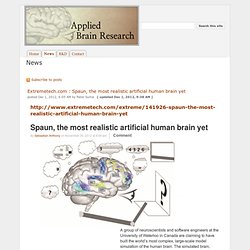

Computers will have emotional intelligence by 2029. Erik Brynjolfsson: The key to growth? Race with the machines. How do you gauge if strong A.I. is a few years away? (credit: unknown artist) Mr.

Kurzweil, I’m currently in the middle of How to Create a Mind. I’m struggling with this one a bit more than you’re other books, but it’s very enjoyable and elucidating. You have for some time predicted human level machine intelligence arriving by 2029. However, in Mind you estimate the speed of a computer necessary to simulate the brain at 100 trillion cps, and state that the latest supercomputers achieve this speed. Which means that very soon we will have a machine with twice the necessary power, then quadruple, and so on. If four or five years from now we have a computer of ten times the necessary power AND there emerges a well-funded, collaborative effort to simulate a brain on such a machine, would you amend your prediction of the emergence of strong AI?
I guess what I mean to ask is, what developments would you look for to determine that strong AI is only a few years away? Regards,Sean Sean, I’ve always expected to have the hardware sooner. Best,Ray Kurzweil. Canadian scientists create a functioning, virtual brain. Chris Eliasmith has spent years contemplating how to build a brain.

He is about to publish a book with instructions, which describes the grey matter’s architecture and how the different components interact. So Eliasmith’s team built Spaun, which was billed Thursday as “the world’s largest simulation of a functioning brain.” Spaun can recognize numbers, remember lists and write them down.
It even passes some basic aspects of an IQ test, the team reports in the journal Science. Several labs are working on large models of the brain– including the multi-million-dollar Blue Brain Project in Europe – but these can’t see, remember or control limbs, says Eliasmith. “Right now very large-scale models of the brain don’t do anything,” he said in an interview. His Waterloo team took a different approach, using computers to simulate what goes on inside the brain, similar to the way aircraft simulators mimic flight. Smart elevators to get you there faster - Technology & Science.
Ding!

The next-generation elevator should be much faster, thanks to responsive rides that require less waiting, make fewer stops and anticipate your destination. Personal Occupant Requirement Terminal, or PORT, is elevator maker Schindler's solution to vertically growing cities. It's a kiosk with a touch screen in a skyscraper's main floor lobby that replaces the traditional call buttons.
Passengers enter their destination floors, then the kiosk directs them to a particular elevator, grouping people who are going to the same floors. The system and its algorithm will also begin to understand the traffic of the building and track passenger behaviours, such as when they go for lunch or take coffee breaks. Coming up Schindler's James Ellingson talks to CBC Radio's Spark about smart elevators on March 24 at 1:05 p.m. on CBC Radio One.
It's no surprise that this old-fashioned transportation technology is getting the boot. News - ABR, Inc. It goes without saying that the human brain is complex, and would be hard to build from scratch.

But researchers are looking to simulate how the brain works so that more human-like artificial intelligence can be created and we can better understand damage to our own brains. Chris Eliasmith of the University of Waterloo in Ontario, Canada, led research published in the journal Science on a brain model called SPAUN - the Semantic Pointer Architecture Unified Network. SPAUN lives inside a computer, can view images with a camera-like eye and can draw responses to questions. For example, show it the number "4" and it will write its own "4. " It can even mimic the style of the numeral. Both in the brain and in SPAUN, neurons communicate by changing their voltages, and the pattern of these voltage "spikes" is what carries information from one cell to another, Eliasmith said. SPAUN has 2.5 million spiking neurons. It's hard to compare SPAUN to any existing animal.
Artificial Neural Networks.